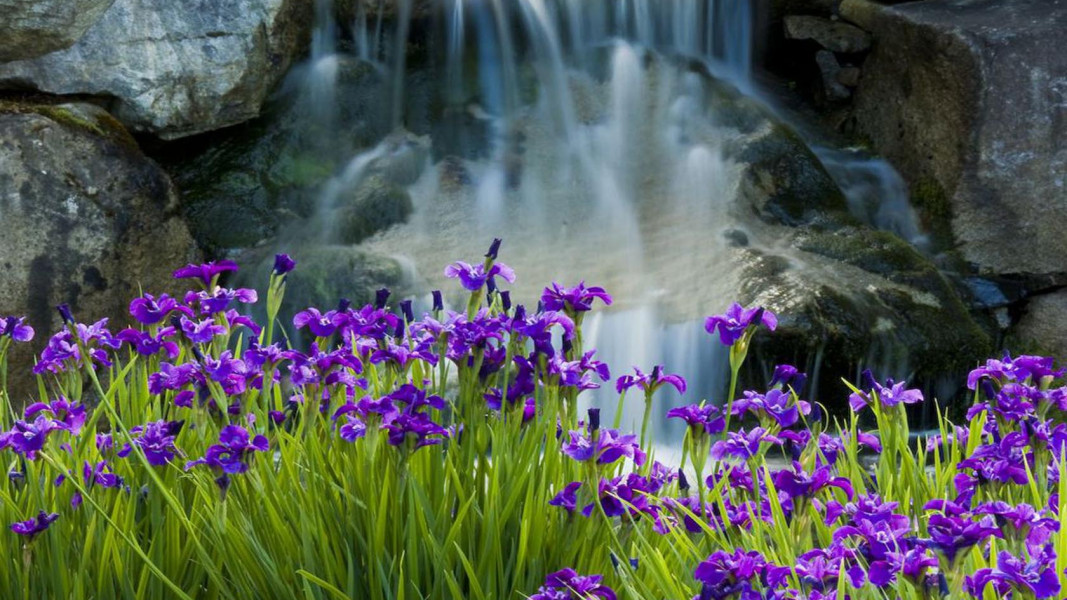Origins of irises
The iris got its name in ancient Greece and was named after the goddess Iris, who as an ambassador of the gods descended to earth in a rainbow. Carl Linnaeus was the first to propose a unified system for the nomenclature of these plants and thus preserved their ancient name "iris" (rainbow) to this day.
In the garden, irises very well fill the "pause" after the blooming of tulips and daffodils until the flowering of peonies and lilies, for example. The exceptional beauty of irises, their original leaves, preserving their greenery until autumn, allow their use in a variety of layouts of flower areas in the garden - individually, as border plants, in groups among the grass, combined with other perennials, around small ponds etc.
Diversity of irises
The group of irises is huge. In it you will find both specimens - 4 in and dwarfs that barely protrude above the ground. The colors are very different, and the flowering period is from November to July, depending on the variety. Classification is complex, but the main species are easily distinguished. The two main groups are rhizome and bulbous.
Rhizome group irises
In the rhizome group are the most popular varieties. The irises extend horizontally through a thickened stem that is partially or completely underground. The most common are bearded irises - they are recognized by the hairs on the downward-facing outer petals. A fan of flat and broad leaves forms at the top of the rhizomes. Bearded irises are planted soon after the flowers wither and on a day when the soil is moist. Place them about 12 in away, the upper half should remain uncovered; the tips of the leaves are removed. Most gardeners are content with bearded irises, but the rhizome group includes other varieties. Naked irises have smooth outer petals and rhizomes located below the soil surface - plant at a depth of 1-2 in. Hooded irises are the least numerous. There are no hairs on their outer petals, but a raised strip of fabric.
Bulbous group irises
The irises of the bulb group are smaller than most irises of the rhizome group. They are suitable for the rock garden or for the front part of the curb. They bloom in winter, spring or summer, depending on the species. They are difficult to survive in winter - some species are delicate, and almost all need light soil with good drainage properties. You should not take them out and separate the tufts for at least four or five years after planting.
Planting
The place for the irises should be chosen in advance and prepared. It is best not to have wind there, and in the second half of the day to fall in light shade. Garden irises like clayey and sandy soils with a neutral or slightly acidic reaction. If you do not have such soil - better to improve it. Sand and peat should be added to heavy soils, and soils with high acidity should be limed.
Then dig with a straight shovel. This clears the soil of weeds because irises are weak competitors to harmful grasses, especially in the first 2 years after transplanting.
Planting irises involves the following operations: A hole 4 in is dug, a mound of soil is poured on the bottom, and the roots of the plants are distributed on its slopes. The hole is carefully filled with soil. The rhizomes of properly planted irises should be located at surface level. Adherence to these rules leads to rapid rooting. Otherwise, you risk holding back the growth process.
Care of irises
On hot summer days, newly planted rhizomes should not be exposed to direct sunlight and should be shaded. After 3-5 days after planting, depending on the season, the irises are still watered moderately. There is no danger of dying from drying in the middle of the roots, and overwatering leads to the development of bacterial rot of the rhizome. The plant needs watering only during its flowering period and during secondary growth (3-4 weeks after flowering), and only if the weather is too dry. Watering is done in the evening, and care must be taken not to get water on the flowers and rhizomes. Then the ground is carefully loosened. If it is raining heavily, it is advisable to cover the irises with a suitable transparent cover.
With the onset of the first winter frosts 1/3 of the leaves should be cut, and when temperatures drop below zero, the irises are covered. To most effectively protect plants from low temperatures, a dry "shelter" should be made or a non-curing material that is difficult to settle should be used. An example of such a coating is sphagnum moss, on which fir twigs are placed. In the spring, when the snow melts, the moss moves slightly so that air can reach the plant. The cover is removed when the soil has warmed up.
How are irises fertilized?
For the entire growing season, the irises are fed twice. The first - at the beginning of growth, the second - two weeks before flowering. The first fertilization is done with poultry manure: 0.88 lb of dry bird manure is dissolved in 10 liters of water, left overnight and watered around the roots without straining. No additional watering is required. Then it is desirable to slightly loosen with the introduction of clean sand.
The second fertilization was borrowed from the Australian iris grower Berry Blythe. He says that fish emulsion is the best medicine for resuscitation of a weak rhizome. In addition, the need of plants for phosphorus must be taken into account, and tall bearded irises need a large amount of this element. Applying superphosphate in dry form is dangerous. Combined organic and phosphorus nutrition can be used. In addition, phosphorus from fish is non-toxic and well absorbed. Fish manure can be applied without restrictions. It is very easy to prepare. Pass the fish through a meat grinder, dissolve 0.65 - 0.88 lb of the mass in 10 liters of water and after a day pour in the area of growing fans, two weeks before flowering.
However, not everyone was born a gardener. So, If you need cut iris flowers arranged in beautiful bouquets, you can always find such in our collection with
iris flower bouquets. The large variety we offer guarantees you that you will find the most suitable iris masterpiece for you.
So, how do you take care of your irises?

